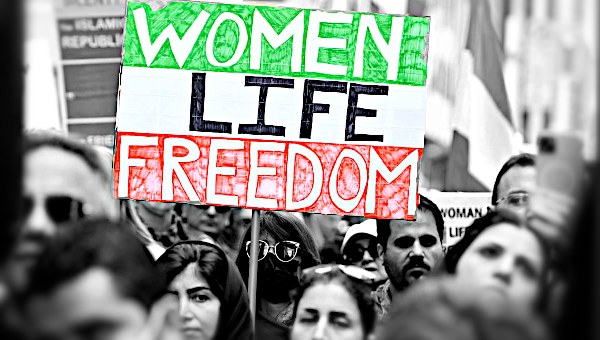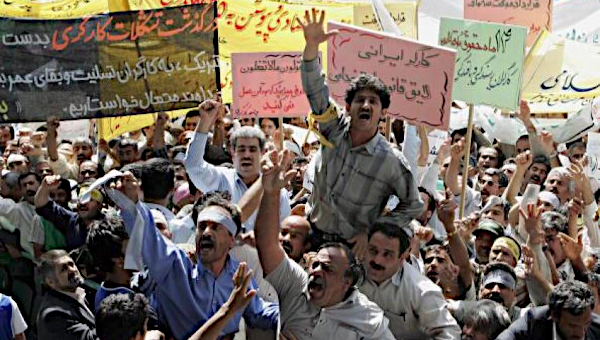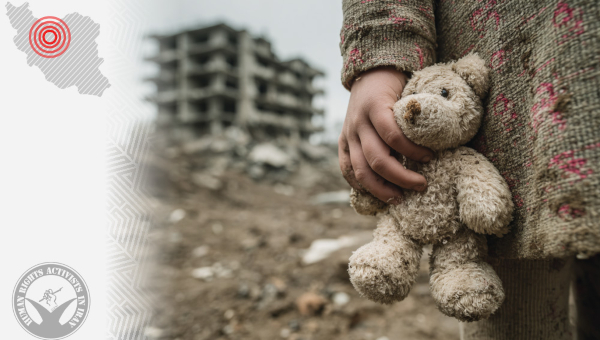Back to Year Zero of the 1979 Iranian Revolution: The ‘Women, Life, Freedom’ Revolt
The time seems to be ripe for the women and the Kurds to write the last year of the Islamic State’s history through rewriting the year Zero of the Revolution.
On July 14, 1789, when the revolutionary insurgents stormed the Bastille in France, Louis XVI asked the Duc de La Rochefoucauld-Liancourt if this was a “revolt,” and the latter replied, “No Sire, it’s a revolution!”
The very question and the same answer have resonated deeply these days amongst Iranians. On the 2nd of October, the students shouted in Mashhad, “This is no longer a protest; it is the beginning of a revolution.” A day before, the students of Beheshti University in Tehran had chanted, “Don’t call it protest, it’s now called revolution.” Likewise, the expression ‘feminist revolution’ is everywhere in the air.1 And yet, despite the general optimism of their will, the material conditions of the continuation of the uprising, and eventually, a political transformation, are not guaranteed.

The Beginning
Let’s start from the beginning. The brutal murder of Jina (Mahsa) Amini by the so-called morality police (Gasht-e ershad) on 16th September 2022 in Tehran sparked indignation and protests against the Islamic Republic, initially in Kurdish regions. The unrest in Kurdistan turned at full tilt into a nationwide insurgency with a universal character, bringing together all dissidents from different social and political backgrounds under the banner of a Kurdish-originated slogan: ‘Women, Life, Freedom’ (Jin, Jiyan, Azadi).
The very imagery of the ‘Women, Life and Freedom’ slogan has opened the space for putting forward a seemingly infinite set of political and socio-economics demands that could not be satisfied simply by reforms such as abolishing the mandatory hijab.
One can no longer imagine a possible point of compromise between the State and the people. All mediation channels between the protestors and the regime are closed. It is worth recalling that the possibility of such a compromise was the raison d’etre of the Reformists (Eslāh-Talabān) in Iran whose discourse had been hegemonic for almost three decades (1991 until 2018).
The multiplicity and inexhaustibility of the demands of the protesters, which are integrated in an all-or-nothing struggle, should be understood in light of Iran’s recent developments. At least since the mid-2010s, Iran has been the scene of a ‘permanent pre-revolutionary crisis’, to use Ernest Mandel’s words, with bloody heterogeneous manifestations,2 among which one could mention two nationwide waves of mass protests, generally due to the deterioration of economic conditions, a sudden rise of prices, and the general pauperization of the population: the Dey-96 uprising (December 2017-January 2018) and the Aban-98 uprising (October and November 2019). We should also mention the protests of the Girl of Enghelab Street (2017) against the compulsory hijab, the Ukraine International Airlines Flight 752 protests (2020), the protest over water and power shortages, especially in Khuzestan province (2021), and at least seven years of labour sit-ins, strikes, and protests against the precaritisation of work and privatizations.
The agents of the protests of 2017-18 and of 2019 in Iran are often considered to be the urban poor and lower-income classes, while the Green movement (2009) and the protest over the shooting-down of the Ukrainian plane (2020) were considered as middle class-led demonstrations. However, the ongoing uprising cannot be characterized simply in terms of ready-made sociological categories. There are signs of upheaval against the existing order of things in practice as well as in the language that interprets it.
The ‘Women, Life, Freedom’ uprising has brought about something new, a transformation of quantity into quality. We are facing a new reality of an unprecedented conjunction of political demands (in face of the crisis of political representation) and economics demands (in face of the crisis of social reproduction). Not only middle-class but also working-class women are active and present in the protests. There are not only riots but also strikes, although the strikes are limited in scale and occurring only in some regions like Kurdistan.
‘Ana-Revolutionary’ Dimension of a Revolt
A revolt or a revolution? In his phenomenology of the Spartacist revolt (1919), Furio Jesi makes a distinction between revolt and revolution in terms of their specific experience of time: while revolution is immersed in historical time, the moment of revolt incarnates absolute suspension of the historical time and every pre-planned orientation.3 The Iranian uprising isn’t yet fortified with a coordinated and long-term strategic complex of movements that can ensure a radical rupture with the status quo in its totality. Nevertheless, it should be considered as a revolution in one specific sense: although the Iranian women-led insurgency has not yet traversed the revolutionary passage beyond the Islamic Republic, it already consists of a revolutionary move in a retroactive direction and in regard to the structural relationality that has been created between the present and the past.
The uprising involves an explicit operation of re-imagining and re-experiencing the moment of 1979 based on different epistemic foundations. More than forty years after the 1979 revolution, the post-revolutionary Iran now seems to be ‘ana-revolutionary’ – ‘ana’ in the sense of ‘again’, and even more, in the sense of ‘in reverse’.
There is an ironic side to the symbolism of the recent uprising: the new generations hardly seem to identify with the terminology of revolution and in particular with that of 1979. In reference to the notion of radical political transformation, the once-preferred word was Barandāzi (the overthrow), i.e., regime change, giving way to the term Enghelāb (the revolution). Once again, Enghelāb is back on the tip of everyone’s tongue. The most popular revolution of the twentieth century, the 1979 revolution, has apparently retrieved its logical and historical resonance. Those activists and commentators who fiercely and systematically attacked the very idea of revolution in the post-soviet ideological zeitgeist – mostly from seemingly two opposing camps: reformist and royalist – now talk plainly about revolution. Those who wanted to erase and bury the memory of the 1979 revolution – among others, the ex-revolutionaries, the royalist sympathisers of the ancient regime – now find themselves all of a sudden in the re-installed scenery of the same revolution. This renewal of the spirit of the 1979 revolution can be explained notably in reference to two forces that are the pioneers and initiators of the ‘Women, Life, Freedom’ uprising: the women of Iran and the Kurds.
The Women and the Kurds
The wave of protests in Iran was triggered by the funeral ceremony of Jina (Mahsa) Amini in Saqqez, her hometown. Thousands of Kurdish residents of Saqqez gathered in the Aychi cemetery, where women removed their headscarves and turned the mourning into indignation, and so, the protest began.4 Since then, women and Kurds, as well as Balochs, have played a significant role in the expansion and continuation of protests.
About forty years ago, at the wake of the 1979 revolution, women and the Kurds were at the forefront of resistance against the Islamists’ monopolization of the power of the State. While the Islamists strived to establish a monolithic and homogenized nation State in the name of the ‘One’ (Allah), the very political existence of the women, the Kurds, and other colonised nations like Balochs, Arabs, etc. meant invoking multiplicity in the face of the ‘One’ – this multiplicity should be understood in reference to the wave of the national liberations of the second half of the 20th century whose main vision was the idea of collective autonomy.
The repression of the women and Kurds by Islamists in the post-revolutionary turmoil marks the passage from the year Zero of the Revolution to Year One of the Islamic Republic. This passage can be formulated in terms of an operation of constitutive exclusion by which the Islamic regime set up its political body by excluding certain differences – differences most notably embodied by women and Kurds.
Year One of the Islamic Republic begins on January 12, 1979 with a decree by Ayatollah Khomeini, issued from a position beyond the law, to constitute the Council of the Islamic Revolution (the state avant la lettre). This was well before the Islamic Republic referendum (the so-called ‘yes or no’ referendum) and even before the overthrow of the Shah’s regime in February 11, 1979 – the date which marks the victory of the revolution. In fact, the Islamic Republic was established and consolidated by a series of decrees issued by Khomeini, the most important being the general disarmament decree on February 13, 1979,5 the mandatory hijab decree for women employees in government offices on March 7, 1979, and the decree (Jihad fatwa) to authorize repression of Kurdish revolutionaries on August 19, 1979.
All the aforementioned decrees targeted either women or the Kurdish population in Iran, serving to pave the passage from the revolution (multiple in its forces and forms) to the Republic (as One). This transition didn’t happen without friction and resistance. On the 8th of March 1979, a day after Khomeini’s decree on the mandatory hijab, thousands of women took to the street while chanting, “We didn’t make a revolution to go backwards.” This protest continued for six days and spread to other cities, and led to the temporary retreat of the seemingly unbreakable and bull-headed Khomeini on the mandatory hijab.
The six-day women’s uprising of March was an unexpected and eruptive mobilization and the first frontal resistance against Ayatollah Khomeini and the new homogeneous body politic formed in his name.6 The women’s resistance found a strong echo among European feminists as well as foreign newspapers, notably because of the linkage between Khomeini’s decree and the international Women’s Day protests.7
The French feminist militants of Des femmes en mouvement, who witnessed first-hand the women’s uprising in Iran, considered it to be a shaking off of the monotheistic edifice of the East and the West.8 The feminist journal Histoires d’elles launched a petition entitled, “With Iranian women, let’s burn our veils and go out into the streets.” It was signed by a wide range of feminist groups and collectives and seems to have been written for today’s events in Iran:
“For the first time in the Third World, women are not allowing themselves to be sacrificed by the revolution. For the first time, they refuse to be brought into line in the name of the revolution to which they contributed, and they make it heard. In the street, at the risk of their lives, they shout that the fight continues against the new masters of the Islamic Republic order.”9
In the aftermath of the 1979 revolution, the Kurds found themselves in an antagonistic situation of oppression running parallel to that of women. In alliance with the Iranian revolutionary communists, and just like the women, the Kurds were at the forefront of a ‘revolution within the revolution’ – the continuation of the revolution despite the Islamic Republic – and eventually a ‘revolution against (counter)revolution’.
In fact, Kurdistan can be considered as the ultimate rampart against the Islamists’ monopolization of power in the early 1980s. Having a deep-rooted communist tradition, activated and incarnated at that time by the Komala Party, Kurdistan was per se the pivotal point of deconstruction and decentralization of the Shia nationalism which was the main ideological pillar of the new regime.
The history of the Kurdish question goes back long before the 1979 revolution. Almost three decades after the termination of the short-lived self-governing Kurdish Republic of Mahabad (12 January 1946 to 15 December 1946), the question of the national self-determination of Kurdistan arose once again in Iran’s post-revolutionary turmoil and practically became the first major geopolitical and regional challenge for the central state of Iran.
The clash between the Kurds and Khomeini emerged soon after the revolution. Almost all Kurdish parties and organizations openly boycotted the Islamic Republic referendum, which was held on March 30-31, 1979, asking Iranians to vote “Yes” or “No” to establishing an Islamic Republic. The two main armed Kurdish parties, the Kurdish Democratic Party of Iran (KDPI) and the revolutionary organization of the Kurdish Toilers of Iran (Komala), joined forces to preserve the de facto autonomy of Kurdish regions that had emerged from the power void left after the revolution and were run administratively by peoples’ councils (Showras) and assemblies (Benkehs). Some of the revolutionary Marxist groups, such as the Iranian People’s Fedai Guerrillas (Dehghani faction), set up their bases in Kurdistan as early as April 1979, and with the intensification of repressive measures by the newly established regime, more communist organizations moved to Kurdistan so that it gradually became the main base of leftist dissidents.
To suppress the revolutionary collective autonomous zones within Kurdistan, Khomeini issued a Jihad fatwa on the 19th August 1979, launching a full-scale military campaign and beginning a bloody civil war. The state of emergency continued long after the repression of the dissidents in Kurdistan, at least until the late 1980s.
In fact, it was during the Kurdistan war that the Islamic Revolutionary Guard Corp was crafted as the primary military arm of the regime. More importantly, the Islamic Republic, as it exists today, was modelled upon a state of emergency declared for the first time in Kurdistan.
Creative Repetition of Missed Possibilities?
Four decades after the revolution, Iranian women and the Kurds have once again engaged in a head-to-head conflict with the Islamic State. Much of the scenery of 1979 has reappeared today, with the very same protagonists on stage. It seems that the endgame of the revolution will be determined on a set remarkably similar to its opening scene. Time seems to be ripe for women and the Kurds to write the last year of Islamic State’s history through rewriting year Zero of the revolution.
If the 2022 Iranian uprising is still distant from entering into a revolutionary conjuncture, like every great political event it has already modified the perception of the past and engendered a new historical imagination. The dominant and uncontested representation of the past of the Iranian regime has been altered. The allegedly outdated notion of Enghelāb has returned to the fore among Iranians, and the spirit of revolution has reappeared. There is a compulsory tendency to associate current occurrences with the events leading to the 1979 revolution. To give an example, the Shah-Cheragh-Mosque massacre in Shiraz (October 2022) is seen as the new cinema Rex fire in Abadan (August 1978).10
All this gives a strong sense of déjà-vu. However, behind the curtain of similarities lurk certain decisive differences. While the 1979 revolution happened at the hinge of a transition from the Cold War divided world to a Pax Americana world order recreated in the form of neoliberal globalization, the ‘Women, Life, Freedom’ uprising is happening in the context of an emergent more complex world order where American primacy and unilateralism is eroding. This can potentially deliver a new competitive phase of geo-political military violence and economic rivalry. The imperialist campaigns of instrumentalization are already at work, as well as a global war of narratives. For the same reason, the women’s movement and the Kurds (and others) should vigorously and vigilantly keep their distance from the West in the same way they are already distant from Moscow.
Another difference concerns the Islamic state’s repressive and ideological apparatuses. Even though the popular base of the Islamic Republic has shrunk massively compared to the early 1980s, the Iranian state today is far more modernized/militarized by advanced technologies of repression. But perhaps the most important difference is not simply that the women, the Kurds and, in general, the secular progressive forces have got the chance to take the power from the so-called backward Islamists; it is that the very logic of articulation of body politics has shifted from a monotheistic pattern toward a polytheistic one, thanks to the ‘Women, Life, Freedom’ movement.
The present has renewed an understanding of the past alongside older divisions re-emerging. But there is still a need to find a way to the future in a neoliberal post-utopian world. Can the “Women, Life, Freedom’ uprising be the first great revolution of the 21st century? Or will it follow the course of the tragic Arab Spring? Will it be drained of its decentralized multiplicity, or will it be able to effectively produce something new from its internal contradictions? Will it be swallowed up in chaotic international tensions and conflicts? There is good reason to see this as only the opening phase of the revolt against the current regime in the making of a new politics. •
Endnotes
- See for example Mona Eltahawy, “Iran’s Feminist Revolution – Women, Life, Freedom,”; “Listen to the Voices of a Feminist Revolution in Iran,” open letter of hundreds of Iranian and foreign academics and artists.
- Ernest Mandel, Late Capitalism, London, Verso, 1978 [1972], p. 61.
- Furio Jesi, Spartakus: The symbology of revolt, trans. Alberto Toscano, New York, Seagull Books, 2014.
- See the video of the funeral.
- See Ettela’at, 12th February 1979, p. 2.
- As it’s reported by the State newspaper Ettela’at, Women protesting the mandatory hijab gathered in Tehran University and chanted: “We are fighting against compulsory hijab”; a group of men also gathered outside the university and chanted: “Hijab is the best adornment of a woman.” Demonstrations of protesting women were carried out from the university to Azadi Square and then, to the Palace of Justice. Arriving in front of the prime minister’s office, the women demanded to meet Mehdi Bazargan, the prime minister. In this march, some potshots were fired. See Ettela’at, 8th March 1979, p. 2.
- Mahnaz Matin and Nasser Mohajer, Khizesh-e Zanan-e Iran dar Esfand 1357: Tavalodi Digar [Iranian women’s uprising in March 1979: Another birth], Vol. 1, Paris, Noghte, 2013, p. 8. See also the short documentary of Sylvina Boissonnas, Claudine Mulard, Michelle Muller “Mouvement de libération des femmes iraniennes, année zéro.”
- “Téhéran: 50,000 femmes dans la rue,” La Gueule ouverte, n° 253, 21 mars 1979, p. 20.
- “Avec les Iraniennes, brûlons les voiles et sortons dans la rue”, Questions féministes, mars 1979, n° 6. See also Marie-Jo Bonnet, Mon MLF, Paris, Albin Michel, 2018, p. 353.
- On 26 October 2022, 15 people were killed in a mass shooting at Shah Cheragh Mosque, a Shia pilgrimage site in Shiraz. About 44 years ago, more than 377 people burnt in a fire at Cinema Rex of Abadan on August 28, 1978. The incident is considered as a false flag operation by the revolutionaries and gave to the revolution an irreversible momentum. Just like the Cinema Rex fire, the Shah Cheragh attack is mutually blamed on the other by both protesters and government operatives.





